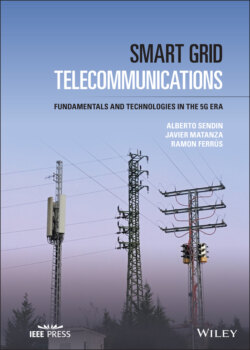Читать книгу Smart Grid Telecommunications - Ramon Ferrús - Страница 30
1.2.4.1 Substations
ОглавлениеSubstations are the grid nodes where voltage level is transformed. PSs transform voltage from HV to MV and SSs from MV to LV. Both PSs and SSs use transformers for this purpose, and as voltage is reduced, current is increased. Voltage transformation takes place in several stages and at several substations in sequence. These substations are connected through power lines.
Other than the transformer as the main component of a substation, substations consist of a complex set of circuit breaking, and control equipment arranged to direct the flow of electric power. Substations perform several functions, namely, safety (isolating parts of the system in case an electric fault occurs), operation (minimization of energy losses; separation of parts of the network when maintenance or network upgrades are needed), and interconnection (if different electric networks with diverse voltages need to be connected).
PSs (Figure 1.5) are designed for several specific functions such as regulating voltage to compensate for system changes, switching transmission and distribution circuits, providing lightning protection, measuring power quality and other parameters, hosting communication, protection, and control devices, controlling reactive power, providing automatic disconnection of circuits experiencing faults, etc. They contain elements such as line termination structures, switchgear, transformer(s), elements for surge protection and grounding, capacitors and voltage regulators, and electronic systems for protection, control, metering, etc. These elements are usually connected to each other through conductor buses or cables within the facility. PSs are quite homogeneous in its design and external appearance. Most of them are big outside compounds where power lines and metallic structures can be easily identified.
Figure 1.5 Primary substation examples.
SSs (Figure 1.6) are located at the edge of MV networks, close to end‐users, where electricity is transformed to LV for Consumption Points. LV grids are deployed to reach the customers, and therefore, SSs are located close to the end‐users. In Europe, SSs normally supply an LV area corresponding to a radius of some hundred meters around the SS; North and Central American Distribution networks consist of an MV network from which numerous (small) MV/LV transformers supply one or several consumers, by direct service cable (or line) from the SS transformer location (thus SSs may be just a number of small transformers on top of a pole).
The number of SSs in the grid exceeds the number of PSs with a factor than can be in excess of 100. Due to their relevance in the evolution into the Smart Grid, it is worth describing the structure of an SS, from its MV input to its LV output:
MV lines. These are the power lines carrying voltages and currents that originate from PSs.
Switchgear or MV panels. These are the interfaces between MV lines and the transformer or transformers. The switchgear protects the transformer and allows the interconnection of MV feeders. Switchgear maybe open‐air or encapsulated air‐insulated (old versions) or encapsulated with a gaseous dielectric medium (usually sulfur hexafluoride, SF6).
Transformer. The device that steps down the voltage from MV levels to LV.
LV panel. The element located beyond the transformer, connected to its secondary winding, and distributing the electric power in a number of LV feeders that will eventually reach Consumption Points. It is usually a large single panel or frame composed of four horizontal bars where the LV feeders are connected (for the three phases and the neutral). The LV switchboard usually is fitted with switches, overcurrent, and other protective elements.Figure 1.6 Different types of secondary substations.
LV feeders. These are the power lines supporting specific voltages and currents that deliver electric energy to customers. Usually several LV lines come out of a single SS, which then provide electric service to buildings and premises around.
SSs are more diverse in its nature, dimensions, and external appearance than PSs. The main reason lies in the need to adapt to the physical surroundings and specificities of the Consumption Points. SSs can thus be located indoor (in shelters, integrated in building spaces, or underground) or outdoor (with overhead transformers on poles or in compact surface cabinets – padmount transformers – or similar).
